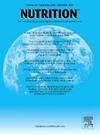孕前肥胖是新生儿出生时维生素K缺乏的独立危险因素
IF 3
3区 医学
Q2 NUTRITION & DIETETICS
引用次数: 0
摘要
新生儿维生素K缺乏(VKD)是已知的维生素K缺乏性出血(VKDB)的危险因素,这是一种潜在的危及生命的疾病。然而,产妇在出生时发生VKD的危险因素仍然知之甚少。目的本研究旨在确定与新生儿出生时VKD相关的母亲因素,重点关注孕前肥胖。方法对2018 - 2023年我院收治的新生儿进行回顾性匹配病例对照研究。VKD定义为维生素K缺失- ii (PIVKA-II)诱导的血清蛋白在给药前第0天≥1000 mAU/mL。对于每个VKD病例,选择两个胎龄和性别匹配的对照组。比较产妇背景特征,并进行多因素logistic回归,以确定新生儿VKD的独立危险因素。结果在64例VKD新生儿和128例对照组中,VKD组孕妇孕前肥胖(体重指数≥25)发生率显著高于对照组。多因素分析发现,孕前肥胖是新生儿VKD的独立危险因素(优势比3.97,P < 0.001)。此外,孕妇孕前BMI与新生儿出生时PIVKA-II水平呈正相关(r = 0.285, P < 0.0001)。结论孕妇孕前肥胖与新生儿VKD风险增加独立相关。这些发现表明,有针对性的评估和维生素K管理策略是必要的,在妊娠合并产妇肥胖。本文章由计算机程序翻译,如有差异,请以英文原文为准。
Prepregnancy obesity is an independent risk factor for neonatal vitamin K deficiency at birth
Background
Neonatal vitamin K deficiency (VKD) is a known risk factor for vitamin K deficiency bleeding (VKDB), a potentially life-threatening condition. However, maternal risk factors for VKD at birth remain poorly understood.
Objective
This study aimed to identify maternal factors associated with neonatal VKD at birth, with a focus on prepregnancy obesity.
Methods
We conducted a retrospective matched case–control study of neonates admitted to our hospital between 2018 and 2023. VKD was defined as serum protein induced by vitamin K absence-II (PIVKA-II) levels ≥1000 mAU/mL on day 0 of life before vitamin K administration. For each VKD case, two gestational age- and sex-matched controls were selected. Maternal background characteristics were compared, and multivariate logistic regression was performed to identify independent risk factors for neonatal VKD.
Results
Among 64 neonates with VKD and 128 controls, maternal prepregnancy obesity (body mass index ≥25) was significantly more common in the VKD group. Multivariate analysis identified prepregnancy obesity as an independent risk factor for neonatal VKD (odds ratio 3.97, P < 0.001). Additionally, maternal prepregnancy BMI was positively correlated with neonatal PIVKA-II levels at birth (r = 0.285, P < 0.0001).
Conclusions
Maternal prepregnancy obesity is independently associated with an increased risk of VKD in neonates at birth. These findings suggest that targeted evaluation and vitamin K management strategies are warranted in pregnancies complicated by maternal obesity.
求助全文
通过发布文献求助,成功后即可免费获取论文全文。
去求助
来源期刊

Nutrition
医学-营养学
CiteScore
7.80
自引率
2.30%
发文量
300
审稿时长
60 days
期刊介绍:
Nutrition has an open access mirror journal Nutrition: X, sharing the same aims and scope, editorial team, submission system and rigorous peer review.
Founded by Michael M. Meguid in the early 1980''s, Nutrition presents advances in nutrition research and science, informs its readers on new and advancing technologies and data in clinical nutrition practice, encourages the application of outcomes research and meta-analyses to problems in patient-related nutrition; and seeks to help clarify and set the research, policy and practice agenda for nutrition science to enhance human well-being in the years ahead.
 求助内容:
求助内容: 应助结果提醒方式:
应助结果提醒方式:


